Actuarial careers
Industry topics

Claim your CPD points
In summary:
|
We estimate that there were just over 20,000 (12%) more deaths in Australia in 2022 than we would have expected if there had been no pandemic. Excess mortality is widely regarded as the best measure of the overall impact of a pandemic since it includes deaths both directly and indirectly due to the disease.
Of the 20,200 excess deaths in 2022, we estimate that:
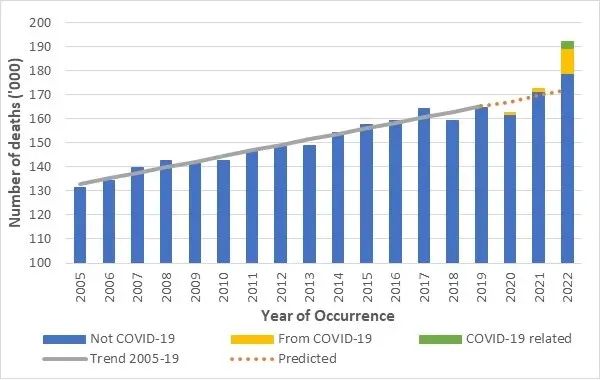
Deaths from COVID-19 are those where COVID-19 is given as the underlying cause of death on the death certificate. Deaths from COVID-19 were the third leading cause of death in Australia in 2022. The main reason why the numbers do not match those derived from surveillance reports is that the latter includes almost all cases[1] where people had COVID-19 when they died. Reported surveillance deaths will include deaths from COVID-19, deaths that were COVID-19 related and other deaths where the doctor/coroner has determined that COVID-19 was incidental and had no role in the death of the person.
For most of the underlying causes of death reported on by the Australian Bureau of Statistics (ABS), the share of COVID-19 related deaths in 2022 is similar to the share of all non-COVID-19 deaths. The exceptions to this are dementia (which is over-represented in COVID-19 related deaths as frail dementia sufferers are also particularly vulnerable to COVID-19), respiratory disease (under-represented as COVID-19 is more likely to determined to be the underlying cause rather than a contributing cause) and coroner-referred deaths (under-represented, but the position could change as coroner findings are made).
It is unclear how close we are to reaching an endemic state when the impact of COVID-19 on mortality will become (more) predictable. Figure 2 shows that the latest wave of COVID-19 deaths continued in January 2023 (estimated at just over 1,000 deaths) but had ended by February 2023 (similar to the lowest month of 2022 at around 350 deaths).
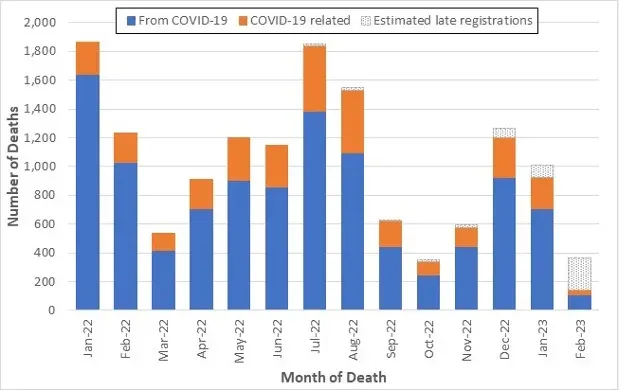
The death certificates of about one-third of excess deaths in 2022 had no mention of COVID-19. These non-COVID-19 deaths represent excess mortality of 4%, which is extraordinarily high in itself, as can be seen in Figure 1. Non-COVID-19 excess deaths are particularly apparent in those aged over 75 for both genders and those aged under 65 for females only. We consider that the most likely reasons for these excess deaths are:
Other possible reasons, which (in our opinion) have had less impact in 2022, include:
In this context, we note that vaccination is highly unlikely to be a cause of excess mortality in 2022. Indeed, given the well-documented reduction in COVID-19 mortality risk conferred by vaccination, the 14 vaccine-caused deaths that had occurred by March 2023 are a fraction of the lives saved by vaccination.
The COVID-19 Mortality Working Group has examined the latest Provisional Mortality Statistics, covering deaths occurring prior to 31 December 2022 and registered by 28 February 2023, released by the Australian Bureau of Statistics (ABS) on 31 March. This release also included the article COVID-19 Mortality in Australia, with details on all COVID-19 deaths occurring and registered by 28 February 2023.
Throughout this article, we separate COVID-19 deaths into:
We calculate excess deaths by comparing observed deaths to our "baseline" predicted number of deaths for doctor-certified deaths (by cause) and coroner-referred deaths (for all causes combined).
The Working Group has also examined excess mortality by age/gender and by state/territory. In so doing, we have used additional data supplied by the ABS in a customised report in relation to COVID-19 deaths registered by 28 February 2023, namely:
We also assess where COVID-19 sits in terms of leading causes of death in Australia.
Our previous Actuaries Digital article discussed in some detail how we arrived at our baseline predicted deaths. In short:
The baselines for our estimates of excess deaths remain "in the absence of the pandemic" for each of the three years 2020 to 2022. We have not included any COVID-19 deaths in the baseline, as these would not exist in the absence of the pandemic.
As always, it is important to note that predicted death numbers are increasing faster from demographic changes (ageing and population size) than they are reducing due to mortality improvement. Therefore, our model predicts higher baseline numbers of deaths in each successive year.
The results we present here differ from those quoted by the ABS in its commentary surrounding the release of the Provisional Mortality Statistics. The ABS explicitly states that the comparison presented is not an official estimate of excess mortality and that their baseline for 2022 (being the simple average of the number of deaths from 2017, 2018, 2019 and 2021, with no allowance for mortality trends or demographic changes) merely serves as a proxy for the expected number of deaths.
For example, the latest Provisional Mortality Statistics says: "In 2022, there were 190,394 deaths that occurred by 31 December and were registered by 28 February 2023, which is 25,235 (15.3%) more than the historical average."
By comparison, we estimate that there were 20,200 (12%) excess deaths in this period. The main reason for the difference between the ABS figure of 25,235 and our estimate of excess deaths of 20,200 is the difference in the baselines used.
Figure 3 shows the results of our analysis, comparing actual deaths each week to our predicted values and the 95% prediction interval.
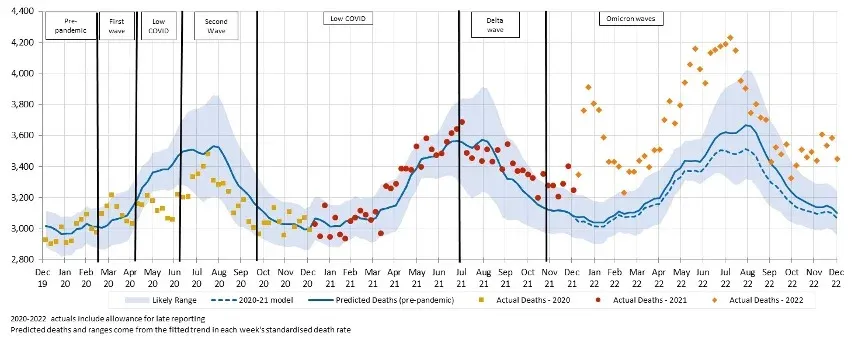
In December, all weeks were well above the upper end of the prediction 95% prediction interval, as has been the case for the majority of 2022. The only period where deaths were not outside the prediction interval was from around mid-August to end-October when COVID-19 prevalence in Australia was relatively low.
Figure 4 shows deaths from COVID-19 and COVID-19 related deaths, noting that, given small numbers, weekly data for COVID-19 related deaths is only available for 2022.
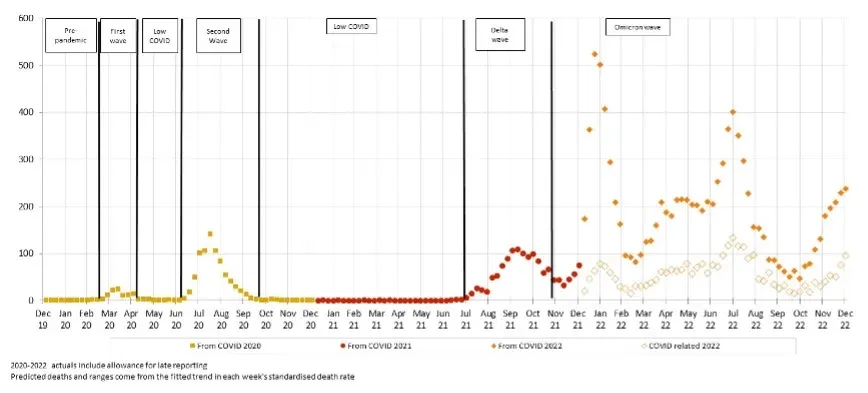
* COVID-19 data from ABS customised report 2023
Deaths from COVID-19 increased across November and December, averaging over 200 deaths per week in December. COVID-19 related deaths have followed the same pattern as from COVID-19 deaths.
It is unclear how many people whose deaths were COVID-19 related would have died during this period anyway and how many may have had their death hastened by COVID-19. Given that COVID-19 is considered to have contributed to the death and that these deaths follow the same peaks and troughs as from COVID-19 deaths, it seems that COVID-19 is a catalyst in these deaths rather than being merely coincidental. We note that the same traditionally happens with the winter peak of respiratory disease deaths.
There may be instances where it is difficult to determine whether a death is due to COVID-19 versus COVID-19 being a contributing cause, and an element of professional judgment by the certifier will necessarily need to be exercised. It is unclear to us how often such decisions may need to be made, and how much "blurring" there may be between deaths from COVID-19 and COVID-19 related deaths.
Figure 5 shows the comparison of actual deaths to predicted after removing deaths from COVID-19 and COVID-19 related deaths.
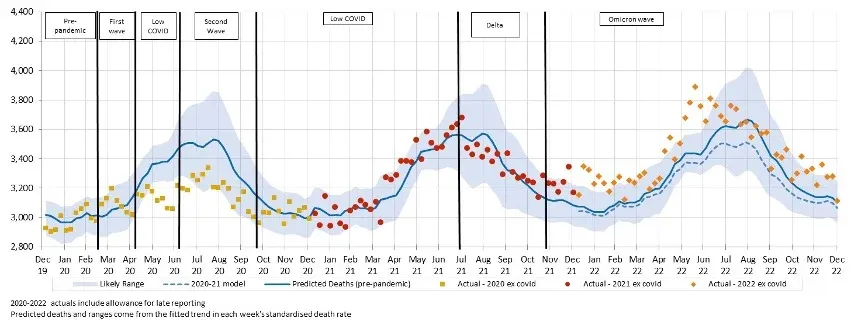
Even after removing all deaths from COVID-91 and those that were COVID-19 related, significant excess mortality remains for 2022, with:
The next section discusses the causes of death driving this trend.
Table 1 shows our estimate of excess deaths broken down by cause.
As in our previous work, we have assumed that coroner-referred COVID-19 deaths will be 5% of all COVID-19 deaths in 2022, based on the experience of late 2021 and the emerging experience in 2022. If our estimate of coroner-referred COVID-19 deaths is too high (or low), this will not affect the total level of excess deaths measured; it will just mean that our estimate of non-COVID-19 coroner-referred deaths will be too low (or high) by the same amount.
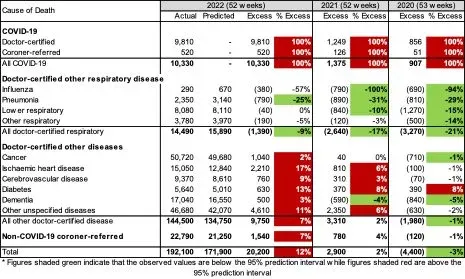
In 2022:
Figure 6 and Figure 7 show weekly excess deaths by underlying cause (thus including COVID-19 related deaths) since the start of the pandemic, compared with the 95% prediction interval. All graphs are shown using the same y-axis to give a sense of the contribution of each cause. The 9-week centred average is also shown to highlight any trends.
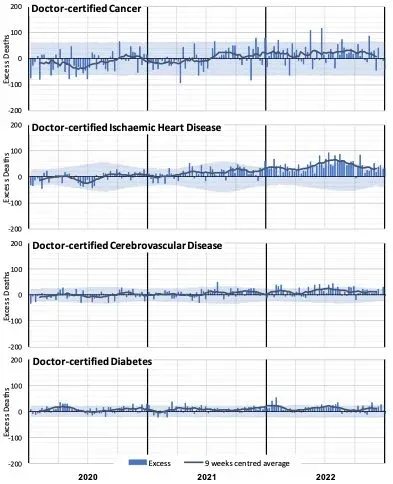
Figure 6 shows a clear increase in excess deaths due to ischaemic heart disease from around March 2021 until around August 2022, with the peaks and troughs following the same timing as deaths from COVID-19 (noting that each chart includes COVID-19 related deaths from that cause). There has been a consistent, albeit volatile, excess for deaths from both cancer and cerebrovascular disease since around July 2021. Diabetes deaths have generally been higher than expected throughout the pandemic, and again the peaks and troughs have followed the same patterns as deaths from COVID-19.
Of these four causes, ischaemic heart disease is the biggest contributor to excess deaths in 2022, followed by cancer.
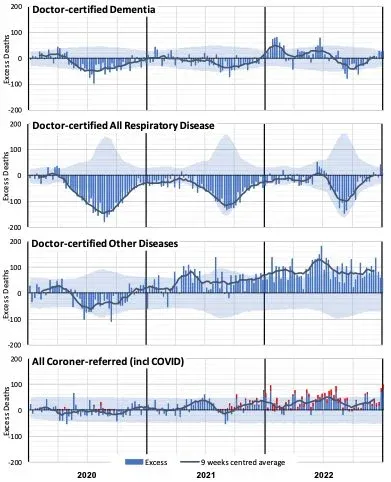
Figure 7 shows negative excess deaths for dementia in 2020, 2021 and September/October 2022 (closely correlated with lower respiratory disease), with higher excess deaths in the first half of 2022 (closely correlated with COVID-19 and flu waves).
Deaths from respiratory disease have been significantly lower than expected throughout the pandemic, except for the short (and early) flu season, which peaked in late June 2022. This coincides with the second 2022 peak in excess non-COVID-19 deaths that we saw in Figure 5.
Deaths from other diseases (where available ABS data does not specify the cause) were also lower than predicted in 2020 (correlated with lower respiratory disease) but have been, as a group, the largest contributor to non-COVID-19 excess deaths in 2021 and 2022. It is not clear what might be driving this, although we expect that at least part of the excess will be in respect of people who otherwise may have succumbed to respiratory disease in 2020 and 2021. We also note that deaths from heart conditions other than ischaemic heart disease traditionally comprise more than 25% of this group and that there does appear to be an increased risk of heart disease after recovering from COVID-19.
Coroner-referred deaths include deaths from COVID-19 that have been referred. In Figure 7, we have separately shown these (in red), using actual coroner-referred COVID-19 deaths for 2020 and 2021 and estimates for 2022 based on our assumption that 5% of all COVID-19 deaths are referred to the coroner. The residual non-COVID-19 coroner-referred deaths are well above expected levels in the second half of 2021 and throughout 2022. We note, however, that suicide monitoring reports for NSW and Victoria show a slight increase in 2022, but not large enough to account for the level of excess seen in those states. Similarly, Australia-wide road death statistics show a small increase in 2022, but not large enough to account for the overall increase.
This section examines COVID-19 related deaths being those where COVID-19 was a contributing factor to the death, but where another cause is listed as the underlying cause of death.
Figure 8 shows, for each of the underlying causes of death reported on by the ABS, the share of COVID-19 related deaths compared with the share of actual deaths (excluding from COVID-19 and COVID-19 related deaths) for 2022.
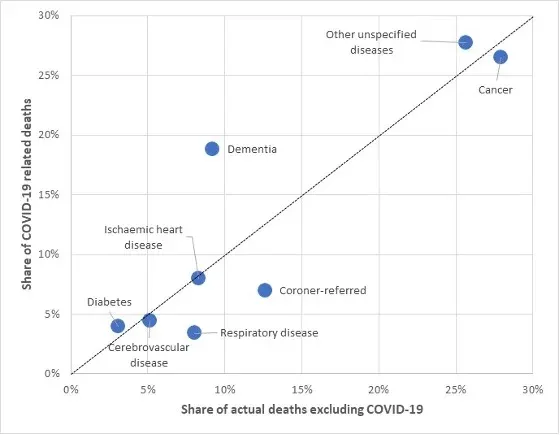
Figure 8 shows that, for most causes of death, the share of COVID-19 related deaths in 2022 is similar to the share of non-COVID-19 actual deaths (most points are close to the diagonal dotted line). However, we can see that:
Note that, in Figure 8, deaths from specified diseases are those certified by doctors. Deaths from disease that have been referred to the coroner are included in coroner-referred deaths.
Table 2 below shows our estimate of excess deaths by age band and gender. We have shown the excess, including all deaths, and then again after deducting from COVID-19 and COVID-19 related deaths.
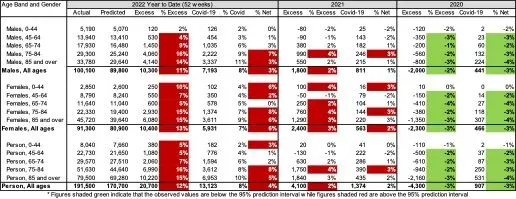
* COVID-19 data from ABS customised report 2023
Almost all age bands show excess deaths in 2022 (which is not all that surprising given the excess deaths for the whole population), but the number and percentage of excess deaths is higher in older age bands. The risk of mortality from COVID-19 is steeper than the underlying age mortality curve, so this result is somewhat expected.
However, it is notable that there are excess deaths in all age groups and that this excess is generally significant, even after removing COVID-19 deaths. To look at this further, we have shown these results similarly to the graphs by cause, showing weekly excess deaths by age band since the start of the pandemic. For these charts, we have been able to show the contribution of deaths from COVID-19 and COVID-19 related deaths (in orange) separately to non-COVID-19 deaths. The 95% prediction interval is also shown. All age bands are shown using the same y-axis to give a sense of contribution of each age band.
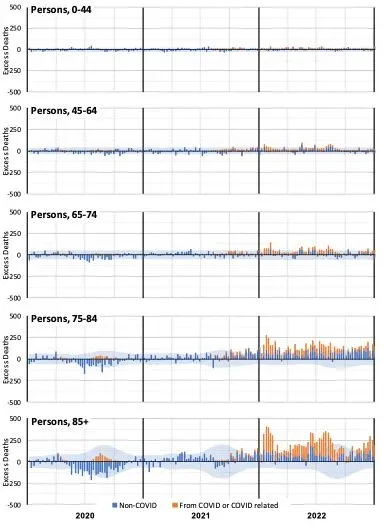
* COVID-19 data from ABS customised report 2023
Figure 9 shows that excess deaths in 2022 are dominated by the older age groups. However, we already expect many more deaths in these age groups. It is instructive to consider the same information with the excess deaths expressed as a percentage of predicted deaths.
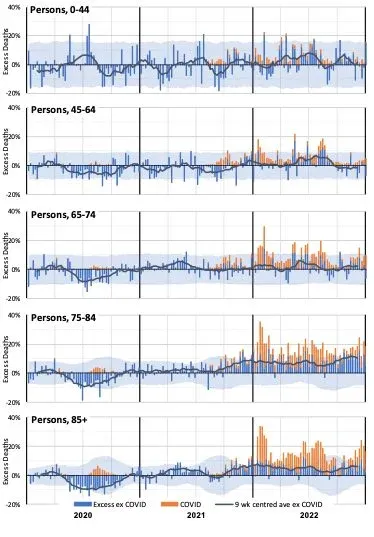
* COVID-19 data from ABS customised report 2023
Figure 10 shows that the older age groups still experienced the most significant increase in excess deaths when expressed as a percentage of predicted deaths. Indeed, deaths of people over the age of 75 are significantly higher than expected in almost every week of 2022.
While the numbers of deaths in the 0-44 and 45-64 age bands are small, we saw in Table 2 that year-to-date excess deaths in 2022 are materially higher than expected. That table also showed that the percentage excess was higher for females than for males.
The differences are worth investigating although the small numbers mean that there is considerable natural variation.
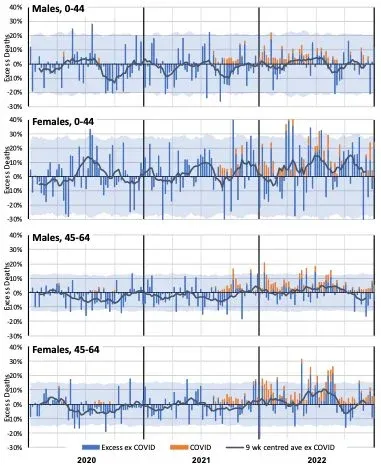
* COVID-19 data from ABS customised report 2023
Figure 11 shows that female non-COVID-19 mortality experience in 2021 and 2022 is noticeably worse than male, especially in the 0-44 age band.
Table 3 shows our estimate of excess deaths by state/territory, before and after deducting from COVID-19 and COVID-19 related deaths.

In 2022, all states/territories apart from NT had significant levels of excess mortality ranging from 10% to 16% of predicted. Generally, about half of this is due to deaths from COVID-19, with another 1-2% due to COVID-19 related deaths.
The graphs below show these results week-by-week (with the excess shown as a percentage of the predicted value) for:
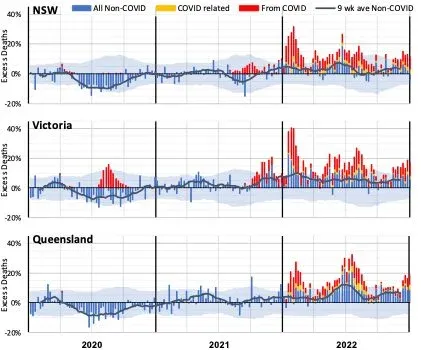
* COVID-19 data from ABS customised report 2023
Figure 12 shows that these larger states all had better-than-expected mortality in 2020. It also shows the impact of the second COVID-19 wave in Victoria.
In 2021, Victoria shows a much higher level of excess deaths in the Delta wave - in the last quarter of the year - than either NSW or Queensland. A large portion of these deaths does not have COVID-19 on the death certificate.
In 2022:
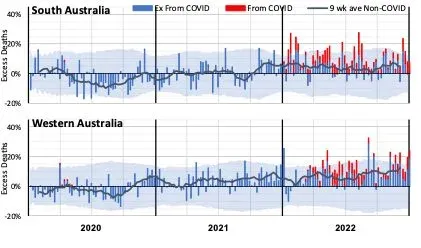
* COVID-19 data from ABS customised report 2023
The SA experience is similar to the three largest states, although somewhat more volatile given its smaller size.
Western Australia, while mostly having excess deaths within the 95% prediction interval, had many more weeks with positive excess deaths than with negative excess deaths. There is no large COVID-19 spike in January and February, thanks to the later opening of WA's borders.

Figure 14 shows the higher volatility of excess mortality experienced by the smallest state and the two territories. Allowing for that volatility, Tasmania had broadly the same experience of excess mortality as the larger states but with a high level of excess deaths during the Delta wave late in 2021.
With its relatively young and affluent population, the ACT has experienced lower excess mortality than the larger states.
The Northern Territory has a very young population, which might explain the low net impact of the pandemic after allowing for the high volatility caused by a very small weekly expected death count. There is no apparent general trend in the excess mortality, although it does appear to have been declining since the middle of 2022. (Note that we have used the same loadings for late-registered deaths for each state. It is likely that registration delays might be longer in the NT compared with larger, more populous states. As such, the reducing trend in excess mortality in the most recent 1-2 months may be a function of our simplified modelling approach rather than a real feature.)
The measurement of higher numbers of deaths than predicted does not tell us why this is occurring. There are several reasons hypothesised around the world (where this effect is occurring to a greater or lesser extent). It isn't possible to identify from death counts alone what is causing the non-COVID-19 excess deaths, but we have listed below the most likely explanations. We note that multiple factors are likely in play, and different factors may be more or less pronounced at various times.
To summarise the evidence from earlier sections:
Based on these observations, the following indicates which factors, in our view, are likely to be having a greater or lesser impact on Australian excess mortality in 2022.
Likely impact in Australia: High during COVID-19 and influenza peaks
Likely impact in Australia: Low to Moderate, likely to increase over time
Likely impact in Australia: Low, perhaps higher during COVID-19 peaks
Likely impact in Australia: Low
Figure 15, which shows excess deaths from doctor-certified respiratory disease, other non-COVID causes and those from COVID-19 and that were COVID-19 related, puts the above into context, across the pandemic.
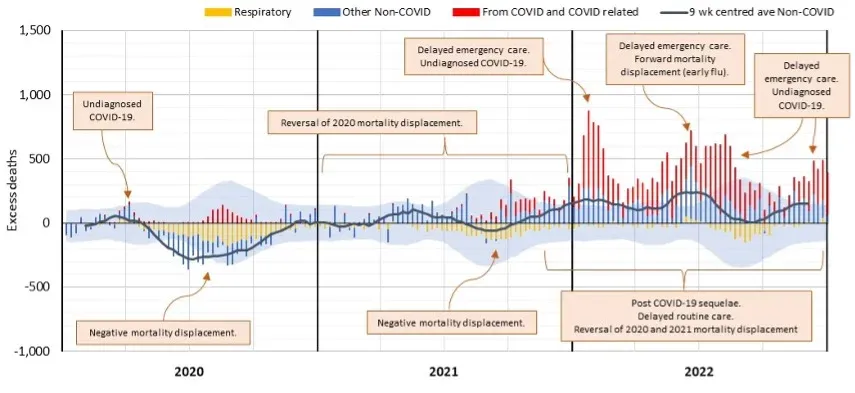
* COVID-19 data from ABS customised report 2023
The ABS reports on the top 20 leading causes of death by grouping deaths based on their International Classification of Diseases, version 10 (ICD-10) code. Cancers are grouped based on the region of the body rather than included as a whole. In this section, we assess where COVID-19 sits in terms of leading causes of death in Australia and have followed the ABS classification system.
We have estimated deaths for the leading causes for 2022. To do this, we have:
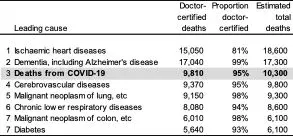
With around 10,300 deaths from COVID-19 in 2022, this puts COVID-19 as the third leading cause of death.
Ischaemic heart disease has been the leading cause of death in Australia for many years. However, the mortality rate for this cause has been declining. At the same time, the population has been aging, resulting in an increasing number of dementia deaths. Our baseline predictions saw dementia overtake ischaemic heart disease to be the leading cause of death in 2022 by a small margin (left panel in Figure 16). However, with the much higher than predicted number of deaths from ischaemic heart disease in 2022, it has remained the leading cause of death (right panel in Figure 16).
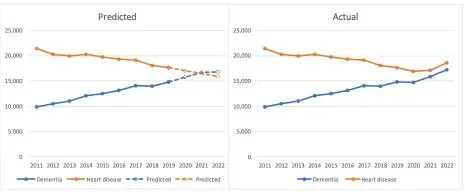
Figure 17 shows the cumulative standardised mortality rates (SDRs) for 2015 to 2022, expressed relative to the rate for 2019. The SDRs are from the Provisional Mortality Statistics, plus an allowance for late-reported deaths.
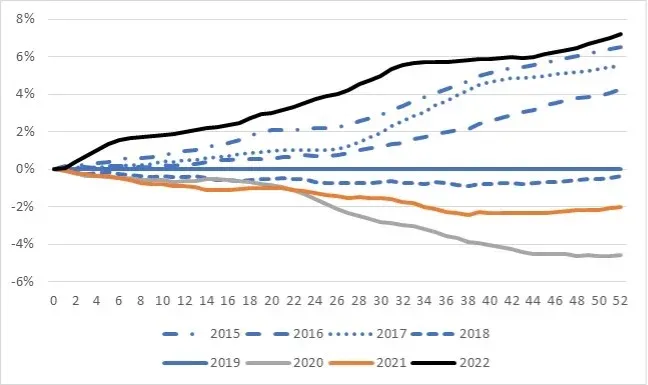
The graph shows that:
This monthly COVID-19 mortality analysis is intended for discussion purposes only and does not constitute consulting advice on which to base decisions. We are not medical professionals, public health specialists or epidemiologists.
To the extent permitted by law, all users of the monthly analysis hereby release and indemnify The Institute of Actuaries of Australia and associated parties from all present and future liabilities that may arise in connection with this monthly analysis, its publication or any communication, discussion or work relating to or derived from the contents of this monthly analysis.
The members of the Working Group are:
[1] Deaths are only excluded where COVID-19 is clearly not the cause, such as death by trauma.
[2] Note that this data comes from the latest ABS COVID-19 article, based on death certificates. While the ABS data is less timely than surveillance reports, deaths are allocated to the month of occurrence rather than the month of (sometimes quite late) reporting.